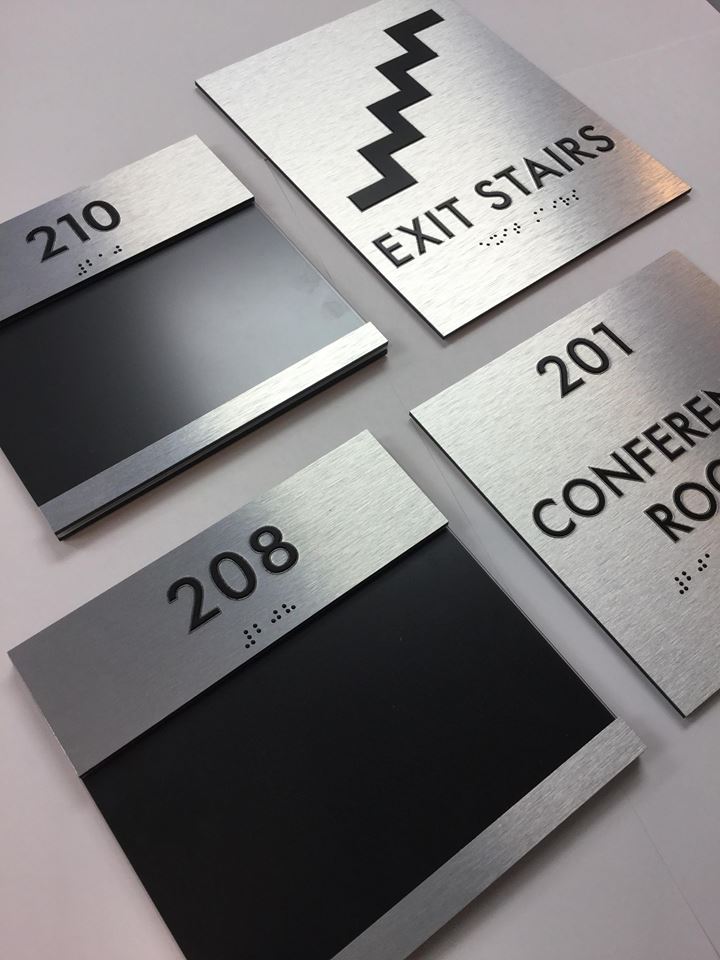Exactly How ADA Signs Improve Access for Everyone
Exactly How ADA Signs Improve Access for Everyone
Blog Article
Exploring the Secret Functions of ADA Indicators for Boosted Accessibility
In the realm of accessibility, ADA indications serve as silent yet powerful allies, ensuring that rooms are navigable and inclusive for individuals with impairments. By incorporating Braille and responsive elements, these indicators break barriers for the aesthetically impaired, while high-contrast color systems and readable fonts provide to varied visual requirements.
Importance of ADA Conformity
Making certain conformity with the Americans with Disabilities Act (ADA) is important for cultivating inclusivity and equivalent accessibility in public rooms and offices. The ADA, passed in 1990, mandates that all public centers, companies, and transport solutions suit individuals with impairments, guaranteeing they appreciate the very same legal rights and possibilities as others. Conformity with ADA criteria not just meets legal responsibilities however additionally improves an organization's reputation by showing its commitment to variety and inclusivity.
One of the crucial elements of ADA compliance is the execution of accessible signs. ADA indicators are designed to ensure that individuals with disabilities can conveniently browse with structures and spaces.
In addition, adhering to ADA policies can mitigate the risk of prospective fines and legal effects. Organizations that fail to follow ADA guidelines may face charges or legal actions, which can be both monetarily challenging and damaging to their public image. Hence, ADA conformity is integral to fostering an equitable setting for everybody.
Braille and Tactile Components
The incorporation of Braille and tactile components right into ADA signage personifies the concepts of accessibility and inclusivity. These features are important for individuals who are blind or aesthetically impaired, allowing them to browse public spaces with greater self-reliance and confidence. Braille, a responsive writing system, is essential in offering composed details in a layout that can be quickly viewed via touch. It is normally put below the matching text on signs to ensure that people can access the info without visual assistance.
Tactile components prolong beyond Braille and include elevated icons and characters. These parts are created to be noticeable by touch, permitting individuals to determine area numbers, bathrooms, departures, and various other vital locations. The ADA establishes details standards concerning the size, spacing, and positioning of these responsive aspects to maximize readability and guarantee consistency across different settings.

High-Contrast Color Design
High-contrast color plans play a pivotal function in boosting the presence and readability of ADA signage for people with visual problems. These plans are crucial as they take full advantage of the distinction in light reflectance between message and history, ensuring that indicators are easily noticeable, also from a range. The Americans with Disabilities Act (ADA) mandates making use of particular shade contrasts to accommodate those with restricted vision, making it a critical aspect of conformity.
The efficiency of high-contrast colors depends on their ability to attract attention in various illumination problems, including dimly lit atmospheres and locations with glare. Typically, dark text on a light background or light message on a dark history is employed to accomplish optimum contrast. Black message on a yellow or white history supplies a raw aesthetic difference that helps in fast recognition and understanding.

Legible Fonts and Text Size
When taking into consideration the layout of ADA signage, the option of readable fonts and proper text dimension can not be overemphasized. The Americans with Disabilities Act (ADA) mandates that fonts have to be not italic and sans-serif, oblique, manuscript, highly decorative, or of unusual kind.
The dimension of the text also plays a critical role in availability. According to ADA guidelines, the minimal text elevation ought to be 5/8 inch, and it ought to raise proportionally with watching range. This is especially important in public rooms where signage needs to be reviewed promptly and precisely. Consistency in text size adds to a natural aesthetic experience, aiding individuals in navigating environments successfully.
Furthermore, spacing in between letters and lines is essential to clarity. Adequate spacing stops personalities from showing up crowded, boosting readability. By adhering to these standards, designers can significantly enhance ease of access, ensuring that signage serves its intended objective for all people, despite their aesthetic abilities.
Effective Placement Methods
Strategic positioning of ADA signs is important for making the most of accessibility and making sure conformity with legal criteria. Correctly located indicators direct people with specials needs successfully, promoting navigating in public areas. Trick factors to consider include distance, height, and exposure. ADA great site standards specify that signs must be placed at a height between 48 to 60 inches from the ground to ensure they are within the line of view for both standing and seated people. This standard elevation variety is important for inclusivity, making it possible for wheelchair individuals and individuals of varying heights to accessibility details easily.
Furthermore, signs have to be positioned nearby to the latch directory side of doors to permit easy identification before access. This positioning helps individuals situate rooms and areas without blockage. In cases where there is no door, indications ought to be situated on the nearby nearby wall surface. Consistency in indication positioning throughout a center boosts predictability, decreasing confusion and enhancing overall customer experience.

Verdict
ADA signs play an essential duty in advertising accessibility by integrating features that resolve the requirements of people with disabilities. These elements collectively promote an inclusive atmosphere, underscoring the relevance of ADA conformity in ensuring equivalent access for all.
In the realm of availability, ADA signs offer as quiet yet effective allies, making certain that rooms are accessible and inclusive for people with disabilities. The ADA, established in 1990, mandates that all public facilities, companies, and transportation solutions accommodate people with impairments, ensuring they appreciate the same civil liberties and opportunities as others. ADA Signs. ADA indicators are developed to make sure that individuals with impairments can conveniently navigate through buildings and spaces. ADA standards stipulate that indicators should be installed at an elevation between 48 to 60 inches from the ground to guarantee they are within the line of view for both standing and seated people.ADA signs play a vital duty in promoting availability by incorporating functions that attend to the demands of people with disabilities
Report this page